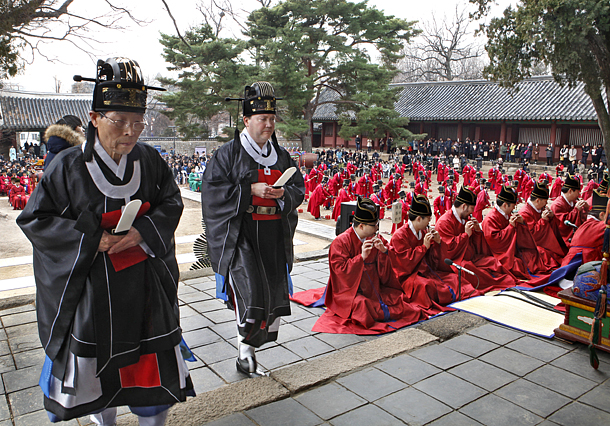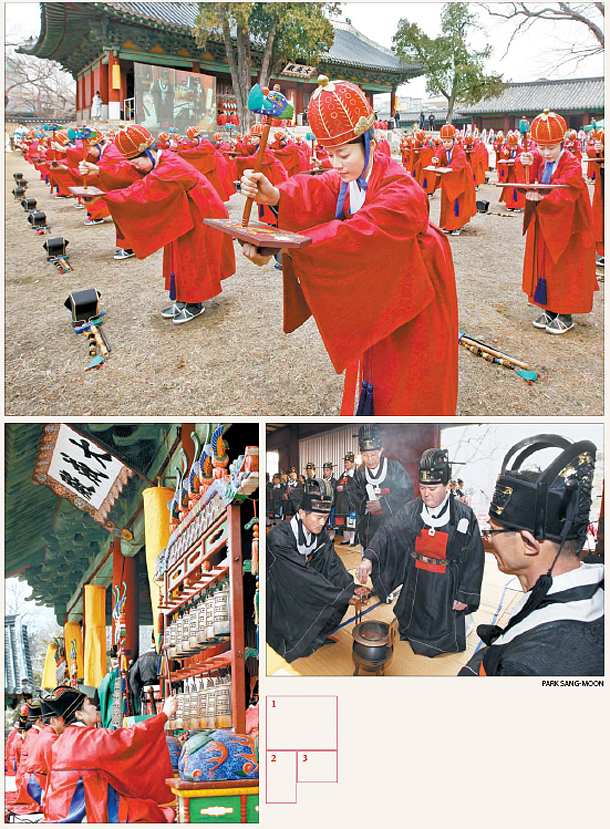Welcoming spring with a time-honored tradition

Marc Knapper, second from left, the Charge d’Affaires at the U.S. Embassy in Seoul, heads to a Confucian Shrine advised by the guide of the ritual, left. Knapper is playing the role of the Choheongwan, the host of the ritual. [PARK SANG-MOON]
Sungkyunkwan Seokjeon, a ritual ceremony dedicated to the Confucian sages, is designated as the National Intangible Cultural Property No. 85.
Seokjeon is a ritual to pay respect to the tablets of Confucius (551 B.C. - 479 B.C.) and his sages who established Confucianism as an academic field at a Confucian Shrine called Munmyo. It is located at Sungkyunkwan, central Seoul, and is dedicated to Confucius - a Chinese teacher, politician and philosopher.
This ritual is held twice a year, in the spring and fall, at Sungkyunkwan, and 234 Confucian Schools. The year 2017 marks the 2568th anniversary of the birth of Confucius. Marc Knapper, the Charge d’Affaires at the U.S. Embassy in Seoul, played the role of Choheongwan, the host of the ritual.
Knapper, who arrived at the site before the ceremony, was given an introduction to the ritual ceremony by the participants at the Myeongnyundang inside Sungkyunkwan.
Knapper took part in the ceremony and treated the task very seriously. He was taught the courtesies, such as how to kneel and bow correctly, and how to properly raise a glass. It was not an easy posture, but he completed the ceremony without a hitch. He took especially dignified steps to the Daeseongjeon, a shrine.

1 The members from an association for the preservation of ceremonial music and dance under the Cultural Heritage Administration perform. 2 Performers from the National Gugak Center play the Munmyo Jeryeak, which refers to traditional dance and music performed at ritual practices held at Munmyo, or shrine of Confucius. 3 Marc Knapper, Charge d’Affaires at the U.S. Embassy in Seoul, kneels in front of the tablet of Confucius and burns incense. [PARK SANG-MOON]
Prior to the event, incense and ritual prayers were delivered to Knapper. The participants of the ceremony took their place, and bowed four times at the same time. When the Seokjeon begun, the Choheongwan was informed by a guide to wash his hands and started the ritual.
Advised by his guide, the U.S. envoy approached the ancestral tablet of Confucius and kneeled facing north. At this moment, ritual music was playing and the performers started to dance to mark the beginning of the grand ceremony. The Choheongwan burned incense three times and paid his respects to the tablet. Then, the ritual continued on to the tablets of Anja, Jeungja, Jasaja, and Mencius, famous Confucian scholars, as well.
After the first ritual concluded, the second ceremony continued, where the Choheongwan raised a glass and read out the written prayers.
At Seokjeon, 39 sages are honored. As well as Confucius and Mencius (372 B.C. - 289 B.C.), and other influential Confucian scholars, ten disciples of Confucius are included in this ritual. Additionally, 18 Korean Confucian scholars from the Goryeo (918-1392) and Joseon Dynasty are also included in the ceremony. Prominent Confucian scholars from the Joseon Dynasty such as Yi Hwang (1501-70) and Yi Yi (1536-84) are also included.
Seokjeon’s origin can be traced back to around the time of King Sosurim of the Goguryeo Dynasty (37 B.C. - A.D. 668). The exact period when Confucianism was introduced is not clear, but the first education facility, known as Taehak, was established during that time and Seokjeon is believed to be practiced around this time as well.
Seven years into the reign of King Taejo (1335-1408), the first king of the Joseon Dynasty, Sungkyunkwan was built in the same spot.
Alongside Daeseongjeon, where the tablets of Confucius and the sages are held, Myeongnyundang, a place for the scholars as well as supplementary buildings are also located.
Seokjeon is practiced every year at Sungkyunkwan.
moonpark@joongang.co.kr










with the Korea JoongAng Daily
To write comments, please log in to one of the accounts.
Standards Board Policy (0/250자)